Well known Japanese developer SHINTA has been recently working on a port of the Anthy free Japanese conversion engine to Haiku, and the first fruits of his work are now available for download from Bebits.com in the form of an Anthy for Haiku binary. It's great to see SHINTA-san in full development mode, and that he has shown his commitment to Haiku by porting Anthy to our OS. Anthy is definitely the best open source Japanese input method, and being able to use it in Haiku is a great plus for anyone who will want to use Japanese in our platform.

Back in the 90s, BeOS had many very faithful followers in Japan, both end users and developers. You can still see on the web photos of how people lined up late at night to get their hands on BeOS 4.5J released by PlatHome, the BeOS distributor in Japan (more pics here). Japanese developers also contributed a good amount of software for BeOS back in those days, some of which has made it into the Haiku code base (ie., the Canna Japanese input method, the MuTerm terminal on which the Haiku terminal is based, etc.). The Konatsu font used in Haiku to display Japanese is also an original creation by Masuda Mitiya, originally designed specifically for BeOS. Sadly but understandably, not many of these former BeOS fans remain active today; in fact, only very very few.
I was one of the founding members of the Japan BeOS Network user group (JPBE.net) in Japan, which we created in 2003 mainly in response to the appearance of ZETA. Back in those days, when Haiku was still at a too early stage to have any appeal, ZETA gave the JPBE.net members hope that BeOS could survive and even evolve. As time went by, our hope gradually changed into to the realization that ZETA was not what we thought it would be, and that realization eventually changed into the final disapointment brought by the sad unraveling of ZETA and yellowTAB. The end was particularly nasty in Japan, where the ZETA distributor sold the shipped product but never had the decency to pay royalties to yellowTAB. Not that this was the direct and only cause of yellowTAB's demise, but in the eyes of Japanese users, this did add a large dose of extra drama to how ZETA went down in history, making the disapointment even greater. The "ok, I've had enough; I am moving on" feeling was quite prevalent.
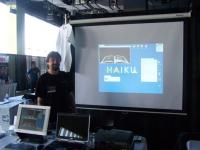 Scott at the Haiku booth
Scott at the Haiku booth
I spent this past weekend in San Francisco in order to attend the LugRadio Live USA 2008 event. Together with Scott McCreary (of BeDrivers.com fame), we organized a Haiku booth to represent the project at this the first LugRadio Live event to be held in the US. This event was a bit of a mystery to me, in the sense that I did not know what to expect. It certainly turned out to be an interesting and fruitful experience, not only because of the usual increased visibility that results from having a booth at any open source event, but also because it gave us the chance to get to know and network with quite a few interesting individuals.
I drove into San Francisco on Friday afternoon, as I wanted to check out the exhibit floor at the Metreon and also see if I could setup our projector screen in our booth in advance. We were originally told that there would be a "no hanging stuff from the wall" policy, but it turned out that it was OK for us to hang the projector screen from the tube holding the backwall drapes behind our booth. And that's exactly what I did: with the kind help of one of the on-site crew and a couple of plastic cable straps that I had brought in my show box, I had the screen setup in no time. I spoke with the on-site staff about wireless access, and got all the info that I needed to get my ethernet-wifi adaptor working, so that we could have internet access from Haiku. Once I had the plan for the next day more or less clear in my head, I called it a day, and went back to my hotel room to relax until dinner time.
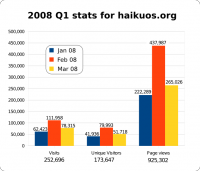 I admit it: I have a weakness for website statistics. So late last year, I added Google Analytics (GA) to the Haiku website. GA gives you a wide array of information such as number of visits, page views, bounce rates, as well as geographic data and information related to the used operating systems. I wanted to get see this information myself, but I also wanted to share it with the community (don't worry, it's all anonymous data), so that everyone can get a peek at another and different metrics of how our project keeps growing over time. So here is a brief activity overview for the Haiku websites for the January thru March of 2008 period.
I admit it: I have a weakness for website statistics. So late last year, I added Google Analytics (GA) to the Haiku website. GA gives you a wide array of information such as number of visits, page views, bounce rates, as well as geographic data and information related to the used operating systems. I wanted to get see this information myself, but I also wanted to share it with the community (don't worry, it's all anonymous data), so that everyone can get a peek at another and different metrics of how our project keeps growing over time. So here is a brief activity overview for the Haiku websites for the January thru March of 2008 period.
As some of you may know, in the ZETA days I worked for yellowTAB in a consulting capacity. At that time, the market I was involved in was Japan, and as a marcom specialist, I make it a point to develop relationships with representatives of the media of that country in order to gain exposure for the product. Of all, there was one magazine in particular that always showed a lot of interest in our platform, and that was Software Design magazine (SD).
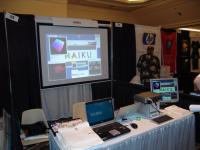 Haiku booth ready for the showThis past weekend Bruno G. Albuquerque, Joe Bushong and myself represented Haiku at the sixth Southern California Linux Expo conference, best known as SCaLE 6x, held on February 9 and 10 in the city of Los Angeles. This was the second year in a row that we organized a presence for Haiku at this event, and since we had so much fun last year (here are two reports and photos from 2007), we were all looking forward to doing it again this time around.
Haiku booth ready for the showThis past weekend Bruno G. Albuquerque, Joe Bushong and myself represented Haiku at the sixth Southern California Linux Expo conference, best known as SCaLE 6x, held on February 9 and 10 in the city of Los Angeles. This was the second year in a row that we organized a presence for Haiku at this event, and since we had so much fun last year (here are two reports and photos from 2007), we were all looking forward to doing it again this time around.
I picked up Bruno from San Francisco airport on Wednesday February 6 at around midnight; he was supposed to arrive a few hours earlier, but he missed his connection flight in New York. The next day, Bruno and I prepared everything for the booth, including setting up our own demo machines (he had Haiku running in VMWare on a MacBook Pro, I had it running natively on my HP Pavilion zv5000 laptop), testing the projector with my (oldish) small cube computer running an AMD XP 1.7G CPU with 1GB RAM, and finishing up and printing the Haiku flyers to handout at the booth. We also could not resist the temptation, and ended up buying a projector screen (we split the cost) so that we could show Haiku running on the backwall of the booth. My wife also did her part, and volunteered to iron and nicely fold about 15 Haiku t-shirts to sell at the booth. By dinner time, we had almost everything ready.
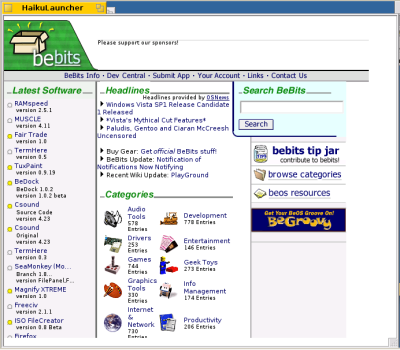 Webkit rendering bebits.comIt looks like the Haiku Webkit port initiated by Ryan Leavengood has entered a productive second stage of development, and thanks to the recent work by one of the new project team members, Andrea "xeD" Anzani, tangible progress has been made as shown by the recent screenshot showing the HaikuLauncher application rendering bebits.com (shown to the right). I was curious about his work, so I went directly to the source and asked a few questions to Andrea; here are his answers.
Webkit rendering bebits.comIt looks like the Haiku Webkit port initiated by Ryan Leavengood has entered a productive second stage of development, and thanks to the recent work by one of the new project team members, Andrea "xeD" Anzani, tangible progress has been made as shown by the recent screenshot showing the HaikuLauncher application rendering bebits.com (shown to the right). I was curious about his work, so I went directly to the source and asked a few questions to Andrea; here are his answers.
Andrea: From the questions you wrote, it looks like you think we have a working browser here. Well, we don't. I'm sorry to tell you but what you see it's just a proof that the webkit is working. Still incomplete and with a lot of bugs. The webkit is, in short words, a framework for loading, parsing and drawing an html page (including net connections and javascript interpreter). We are working on fixing and finishing it. When we are done with porting the webkit, then we can speak about the development of a web browser.
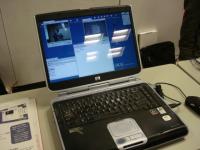 Demo machine at KOF Haiku boothNot surprisingly, it took me much longer than originally planned to find the time to write about the second day at the Kansai Open Source Forum conference (KOF). But no worries: memories are still quite fresh, as it's usually the case when things go well and you have fun. The second KOF day started earlier, especially for me. The exhibits were scheduled to open at 10:00AM, so with Momoziro we decided to meet at the hotel lobby at around 9:00AM. But I was up way before that, at around 5:30AM (compliments of my very jet-lagged old body). So I sat in front of my laptop to write some emails and then went through my Haiku presentation slides again, making little changes here and there, changing the order of a few slides and even adding a couple of slides based on some of the questions that I had received during the first day at KOF.
Demo machine at KOF Haiku boothNot surprisingly, it took me much longer than originally planned to find the time to write about the second day at the Kansai Open Source Forum conference (KOF). But no worries: memories are still quite fresh, as it's usually the case when things go well and you have fun. The second KOF day started earlier, especially for me. The exhibits were scheduled to open at 10:00AM, so with Momoziro we decided to meet at the hotel lobby at around 9:00AM. But I was up way before that, at around 5:30AM (compliments of my very jet-lagged old body). So I sat in front of my laptop to write some emails and then went through my Haiku presentation slides again, making little changes here and there, changing the order of a few slides and even adding a couple of slides based on some of the questions that I had received during the first day at KOF.
This past Friday and Saturday I attended the Kansai Open Source Forum (KOF) conference in Osaka, Japan, to represent the Haiku project together with my Japanese friend and BeOS/Haiku developers Momoziro-san. Here are my impressions from the first day at KOF.
 ATC complex in Osaka, where the KOF conference was held.
ATC complex in Osaka, where the KOF conference was held.
KOF was held at the Asian Trade Center (ATC), located in the waterfront area known as the Osaka Bay Area. ATC is a huge complex of which the KOF exhibit area was only a very small part; the complex has a lot of stores and space for various types of events that are held on a regular basis. Ironically, the KOF exhibit floor was on an area of ATC called the MARE Gallery; I say ironically, because as some may know, Mare is my last name. That and the fact that Japan is like my second home (I lived there for about 23 years) kind of made me feel welcome. ;)
In his Popular Network Preferences applications and comments blog post, GSoC student Andre Alves Garzia gives a great comparative overview of network preferences apps in OS X, Ubuntu, Windows and ZETA, as a means to look for the ideal approach for Haiku.
Andre's post actually reminded me of a few ideas that I had quite some time ago about a BeOS-like way for handling network/email/printer settings (in ZETA, back in the days when I was using it), that I think would still apply for Haiku. I don't know if they are within the scope of what Andre is doing and, not being an engineer, I don't either have a clue whether these ideas can be implemented or not. But I will present them anyway, even at the risk of exposing my sheer ignorance. :)









